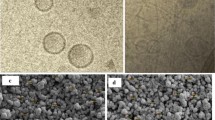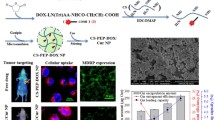Abstract
Purpose
Curcumin is very well established as a chemo-therapeutic, chemo-preventive and chemo-sensitizing agent in diverse disease conditions. As the isolated pure form has poor solubility and pharmacokinetic problems, therefore it is encapsulated in to several nano-formulations to improve its bioavailability. Here in the current study, we aim to compare different nano-formulations of curcumin for their chemo-sensitizing activity in doxorubicin (DOX) resistant K562 cells.
Methods
Four different curcumin formulations were prepared namely DMSO assisted curcumin nano-dispersion (CurD, 260 nm), liposomal curcumin (CurL, 165 nm), MPEG-PCL micellar curcumin (CurM, 18 nm) and cyclodextrin encapsulated curcumin (CurN, 37 nm). The formulations were subjected to particle characterizations (size, zeta potential, release studies), followed by biological assays such as cellular uptake, P-gp inhibitory activity and reversal of DOX resistance by co-treatment with DOX.
Results
Curcumin uptake in K562N and K562R cells was mildly reduced when treated with CurL and CurM, while for CurD and CurN the uptake remained equivalent. However, CurL retained P-gp inhibitory activity of curcumin and with a considerable chemo-sensitizing effect but CurM showed no P-gp inhibitory activity. CurN retained above biological activities, but requires a secondary carrier under in vivo conditions.
Conclusions
From the results, CurM was found to be most suitable for solubilization of curcumin where as CurL can be considered as most suitable nano-formulation for reversal of DOX resistance.







Similar content being viewed by others
Abbreviations
- ACN:
-
Acetonitrile
- DCM:
-
Dichloromethane
- DMSO:
-
Dimethyl sulfoxide
- DOX:
-
Doxorubicin
- DSPE-PEG:
-
1,2-distearoyl-sn-glycero-3-phosphoethanolamine-N-[maleimide(polyethylene glycol)]
- EPR:
-
Enhanced permeation and retention
- FL-1:
-
Fluorescence channel-1
- HP-β-CD:
-
Hydroxyl propyl-β-cyclodextrin
- HSPC:
-
Hydrogenated soy phosphatidyl choline
- MFI:
-
Mean fluorescence intensity
- MPEG-P(CL-co-PDO):
-
Methoxypoly(ethylene glycol)-b-poly(ε-caprolactone-co-p-dioxanone)
- MPEG-PCL:
-
Methoxypoly(ethylene glycol)-b-poly(ε-caprolactone)
- OPA:
-
Ortho-phosphoric acid
- PEO-PCL:
-
Polyethylene oxide-b- poly-ε-caprolactone
- PFA:
-
P-formaldehyde
- P-gp:
-
P-glycoprotein
- PLGA:
-
Polylactic-glycolic acid
- PMS:
-
Phenazine methosulfate
- PVA:
-
Polyvinyl alcohol
- TPGS:
-
D-α-tocopherylpolyethylene glycol
- XTT:
-
(2,3-Bis-(2-Methoxy-4-Nitro-5-Sulfophenyl)-2H-Tetrazolium-5-Carboxanilide)
References
Anand P, Thomas SG, Kunnumakkara AB, Sundaram C, Harikumar KB, Sung B, et al. Biological activities of curcumin and its analogues (Congeners) made by man and Mother Nature. Biochem Pharmacol. 2008;76(11):1590–611.
Gupta SC, Patchva S, Aggarwal BB. Therapeutic roles of curcumin: lessons learned from clinical trials. AAPS J. 2012;15(1):195–218.
Akbik D, Ghadiri M, Chrzanowski W, Rohanizadeh R. Curcumin as a wound healing agent. Life Sci. 2014;116(1):1–7.
Jayaprakasha GK, Jaganmohan Rao L, Sakariah KK. Antioxidant activities of curcumin, demethoxycurcumin and bisdemethoxycurcumin. Food Chem. 2006;98(4):720–4.
Teiten MH, Eifes S, Dicato M, Diederich M. Curcumin-the paradigm of a multi-target natural compound with applications in cancer prevention and treatment. Toxins (Basel). 2010;2(1):128–62.
Anand P, Sundaram C, Jhurani S, Kunnumakkara AB, Aggarwal BB. Curcumin and cancer: an old-age disease with an age-old solution. Cancer Lett. 2008;267(1):133–64.
Shishodia S, Chaturvedi MM, Aggarwal BB. Role of curcumin in cancer therapy. Curr Probl Cancer. 2007;31(4):243–305.
Leonard GD, Fojo T, Bates SE. The role of ABC transporters in clinical practice. Oncologist. 2003;8(5):411–24.
Szakacs G, Paterson JK, Ludwig JA, Booth-Genthe C, Gottesman MM. Targeting multidrug resistance in cancer. Nat Rev Drug Discov. 2006;5(3):219–34.
X-q T, Bi H, J-q F, J-g C. Effect of curcumin on multidrug resistance in resistant human gastric carcinoma cell line SGC7901/VCR. Acta Pharmacol Sin. 2005;26(8):1009–16.
Choi BH, Kim CG, Lim Y, Shin SY, Lee YH. Curcumin down-regulates the multidrug-resistance mdr1b gene by inhibiting the PI3K/Akt/NFIB pathway. Cancer Lett. 2008;259(1):111–8.
Kwon Y. Curcumin as a cancer chemotherapy sensitizing agent. J Korean Soc Appl Biol Chem. 2014;57(2):273–80.
Sreekanth CN, Bava SV, Sreekumar E, Anto RJ. Molecular evidences for the chemosensitizing efficacy of liposomal curcumin in paclitaxel chemotherapy in mouse models of cervical cancer. Oncogene. 2011;30(28):3139–52.
Sharma RA, Gescher AJ, Steward WP. Curcumin: the story so far. Eur J Cancer. 2005;41(13):1955–68.
Shoba G, Joy D, Joseph T, Majeed M, Rajendran R, Srinivas PS. Influence of piperine on the pharmacokinetics of curcumin in animals and human volunteers. Planta Med. 1998;64(4):353–6.
Flora G, Gupta D, Tiwari A. Nanocurcumin: a promising therapeutic advancement over native curcumin. Crit Rev Ther Drug Carrier Syst. 2013;30(4):331–68.
Danhier F, Feron O, Preat V. To exploit the tumor microenvironment: passive and active tumor targeting of nanocarriers for anti-cancer drug delivery. J Control Release. 2010;148(2):135–46.
Rocks N, Bekaert S, Coia I, Paulissen G, Gueders M, Evrard B, et al. Curcumin-cyclodextrin complexes potentiate gemcitabine effects in an orthotopic mouse model of lung cancer. Br J Cancer. 2012;107(7):1083–92.
Yallapu MM, Gupta BK, Jaggi M, Chauhan SC. Fabrication of curcumin encapsulated PLGA nanoparticles for improved therapeutic effects in metastatic cancer cells. J Colloid Interface Sci. 2010;351(1):19–29.
Kumari P, Swami MO, Nadipalli SK, Myneni S, Ghosh B, Biswas S. Curcumin delivery by poly(Lactide)-based co-polymeric micelles: an in vitro anticancer study. Pharm Res. 2016;33(4):826–41.
Lee WH, Bebawy M, Loo CY, Luk F, Mason RS, Rohanizadeh R. Fabrication of curcumin micellar nanoparticles with enhanced anti-cancer activity. J Biomed Nanotechnol. 2015;11(6):1093–105.
Song L, Shen Y, Hou J, Lei L, Guo S, Qian C. Polymeric micelles for parenteral delivery of curcumin: preparation, characterization and in vitro evaluation. Colloids Surf A Physicochem Eng Asp. 2011;390(1-3):25–32.
Wang BL, Shen YM, Zhang QW, Li YL, Luo M, Liu Z, et al. Codelivery of curcumin and doxorubicin by MPEG-PCL results in improved efficacy of systemically administered chemotherapy in mice with lung cancer. Int J Nanomedicine. 2013;8:3521–31.
Bisht S, Feldmann G, Soni S, Ravi R, Karikar C, Maitra A. Polymeric nanoparticle-encapsulated curcumin (“nanocurcumin”): a novel strategy for human cancer therapy. J Nanobiotechnol. 2007;5:3.
Sun M, Gao Y, Guo C, Cao F, Song Z, Xi Y, et al. Enhancement of transport of curcumin to brain in mice by poly(n-butylcyanoacrylate) nanoparticle. J Nanopart Res [journal article]. 2010;12(8):3111–22.
Zou P, Helson L, Maitra A, Stern ST, McNeil SE. Polymeric curcumin nanoparticle pharmacokinetics and metabolism in bile duct cannulated rats. Mol Pharm. 2013;10(5):1977–87.
Dhule SS, Penfornis P, Frazier T, Walker R, Feldman J, Tan G, et al. Curcumin-loaded gamma-cyclodextrin liposomal nanoparticles as delivery vehicles for osteosarcoma. Nanomedicine. 2012;8(4):440–51.
Yadav VR, Prasad S, Kannappan R, Ravindran J, Chaturvedi MM, Vaahtera L, et al. Cyclodextrin-complexed curcumin exhibits anti-inflammatory and antiproliferative activities superior to those of curcumin through higher cellular uptake. Biochem Pharmacol. 2010;80(7):1021–32.
Allijn IE, Schiffelers RM, Storm G. Comparison of pharmaceutical nanoformulations for curcumin: Enhancement of aqueous solubility and carrier retention. Int J Pharm. 2016;506(1-2):407–13.
Beloqui A, Memvanga PB, Coco R, Reimondez-Troitino S, Alhouayek M, Muccioli GG, et al. A comparative study of curcumin-loaded lipid-based nanocarriers in the treatment of inflammatory bowel disease. Colloids Surf B Biointerfaces. 2016;143:327–35.
Kathawate L, Joshi PV, Dash TK, Pal S, Nikalje M, Weyhermüller T, et al. Reaction between lawsone and aminophenol derivatives: Synthesis, characterization, molecular structures and antiproliferative activity. J Mol Struct. 2014;1075:397–405.
Abraham SA, Waterhouse DN, Mayer LD, Cullis PR, Madden TD, Bally MB. The liposomal formulation of doxorubicin. Methods Enzymol. 2005;391:71–97.
Rachmawati H, Edityaningrum CA, Mauludin R. Molecular inclusion complex of curcumin-beta-cyclodextrin nanoparticle to enhance curcumin skin permeability from hydrophilic matrix gel. AAPS PharmSciTech. 2013;14(4):1303–12.
Nag OK, Awasthi V. Surface engineering of liposomes for stealth behavior. Pharmaceutics. 2013;5(4):542–69.
Hu Y, Xie J, Tong YW, Wang C-H. Effect of PEG conformation and particle size on the cellular uptake efficiency of nanoparticles with the HepG2 cells. J Control Release. 2007;118(1):7–17.
Xue C, Wang C, Liu Q, Meng Q, Sun H, Huo X, et al. Targeting P-glycoprotein expression and cancer cell energy metabolism: combination of metformin and 2-deoxyglucose reverses the multidrug resistance of K562/Dox cells to doxorubicin. Tumor Biol. [journal article]. 2016;37(7):8587–97.
Zhu HJ, Wang JS, Guo QL, Jiang Y, Liu GQ. Reversal of P-glycoprotein mediated multidrug resistance in K562 cell line by a novel synthetic calmodulin inhibitor, E6. Biol Pharm Bull. 2005;28(10):1974–8.
Chen W-C, Lai Y-A, Lin Y-C, Ma J-W, Huang L-F, Yang N-S, et al. Curcumin suppresses doxorubicin-induced epithelial mesenchymal transition via the inhibition of TGF-I and PI3K/AKT signaling pathways in triple-negative breast cancer cells. J Agric Food Chem. 2013;61(48):11817–24.
Sadzuka Y, Nagamine M, Toyooka T, Ibuki Y, Sonobe T. Beneficial effects of curcumin on antitumor activity and adverse reactions of doxorubicin. Int J Pharm. 2012;432(1-2):42–9.
Notarbartolo M, Poma P, Perri D, Dusonchet L, Cervello M, D’Alessandro N. Antitumor effects of curcumin, alone or in combination with cisplatin or doxorubicin, on human hepatic cancer cells. Analysis of their possible relationship to changes in NF-kB activation levels and in IAP gene expression. Cancer Lett. 2005;224(1):53–65.
Sen GS, Mohanty S, Hossain DMS, Bhattacharyya S, Banerjee S, Chakraborty J, et al. Curcumin enhances the efficacy of chemotherapy by tailoring p65NF-p300 cross-talk in favor of p53-p300 in breast cancer. J Biol Chem. 2011;286(49):42232–47.
Duan J, Mansour HM, Zhang Y, Deng X, Chen Y, Wang J, et al. Reversion of multidrug resistance by co-encapsulation of doxorubicin and curcumin in chitosan/poly(butyl cyanoacrylate) nanoparticles. Int J Pharm. 2012;426(1-2):193–201.
Qin C-H, Li Y-G, Wu J, He H-J. Curcumin reverses adriamycin resistance of thermotolerant hepatocarcinoma cells by down regulating P glycoprotein and heat shock protein 70. Prog Biochem Biophys. 2012;39(2):151–60.
Wang L, Wang W, Rui Z, Zhou D. The effective combination therapy against human osteosarcoma: doxorubicin plus curcumin co-encapsulated lipid-coated polymeric nanoparticulate drug delivery system. Drug Deliv. 2016:1–9. doi:10.3109/10717544.2016.1162875.
Yallapu MM, Jaggi M, Chauhan SC. Curcumin nanomedicine: a road to cancer therapeutics. Curr Pharm Des. 2013;19(11):1994–2010.
Jantarat C, Sirathanarun P, Ratanapongsai S, Watcharakan P, Sunyapong S, Wadu A. Curcumin-hydroxypropyl-cyclodextrin inclusion complex preparation methods: effect of common solvent evaporation, freeze drying, and pH shift on solubility and stability of curcumin. Trop J Pharm Res. 2014;13(8):1215–23.
Popat A, Karmakar S, Jambhrunkar S, Xu C, Yu C. Curcumin-cyclodextrin encapsulated chitosan nanoconjugates with enhanced solubility and cell cytotoxicity. Colloids Surf B Biointerfaces. 2014;117:520–7.
Singh R, Tønnesen HH, Vogensen SB, Loftsson T, Másson M. Studies of curcumin and curcuminoids. XXXVI. The stoichiometry and complexation constants of cyclodextrin complexes as determined by the phase-solubility method and UV–Vis titration. J Incl Phenom Macrocycl Chem. 2009;66(3):335–48.
Aliabadi HM, Brocks DR, Mahdipoor P, Lavasanifar A. A novel use of an in vitro method to predict the in vivo stability of block copolymer based nano-containers. J Control Release. 2007;122(1):63–70.
Binkhathlan Z, Shayeganpour A, Brocks DR, Lavasanifar A. Encapsulation of P-glycoprotein inhibitors by polymeric micelles can reduce their pharmacokinetic interactions with doxorubicin. Eur J Pharm Biopharm. 2012;81(1):142–8.
Krishna R, McIntosh N, Riggs KW, Mayer LD. Doxorubicin encapsulated in sterically stabilized liposomes exhibits renal and biliary clearance properties that are independent of valspodar (PSC 833) under conditions that significantly inhibit nonencapsulated drug excretion. Clin Cancer Res. 1999;5(10):2939–47.
Acknowledgments and Disclosures
Authors are thankful to Dr Soumen Chakraborty, Institute of life sciences, Bhubaneswar for providing the cell line. Authors acknowledge SERB, Govt. of India, for funding “Fast Track Scheme for Young Scientists” grant (No.SERC/LS-411/2011) and NISER, DAE, Govt. of India, for research fellowship. The authors declare that they have no conflict of interest.
Author information
Authors and Affiliations
Corresponding author
Electronic supplementary material
Below is the link to the electronic supplementary material.
ESM 1
(DOCX 69 kb)
Rights and permissions
About this article
Cite this article
Dash, T.K., Konkimalla, V.B. Comparative Study of Different Nano-Formulations of Curcumin for Reversal of Doxorubicin Resistance in K562R Cells. Pharm Res 34, 279–289 (2017). https://doi.org/10.1007/s11095-016-2060-8
Received:
Accepted:
Published:
Issue Date:
DOI: https://doi.org/10.1007/s11095-016-2060-8




